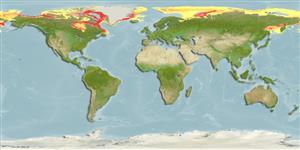>
Perciformes/Cottoidei (Sculpins) >
Cyclopteridae (Lumpfishes) > Eumicrotreminae
Etymology: Eumicrotremus: Greek, eu = good + Greek, mikros = little, small + Greek, trema = hole (Ref. 45335).
Eponymy: Professor Dr Konstantin Michailovich Derjugin (1878–1938) was an oceanographer and marine zoologist at Leningrad State University, and manager of the Oceanic Division of the State Hydrological Institute in Leningrad. [...] (Ref. 128868), visit book page.
Environment: milieu / climate zone / depth range / distribution range
Ecologia
marino demersale; distribuzione batimetrica 5 - 1038 m (Ref. 117245). Polar; 84°N - 50°N, 180°W - 180°E (Ref. 117245)
Arctic to Northwest Atlantic and Northwest Pacific: Canadian Arctic to Hudson Bay, Ungava Bay and Labrador in Canada (Ref. 7251). Arctic Ocean, Barents Sea, Franz Josef Land, Spitsbergen, eastern Greenland, Kara, Laptev, Siberian and Chukchi seas and the Sea of Okhotsk.
Size / Peso / Age
Maturity: Lm ? range ? - ? cm
Max length : 10.0 cm SL maschio/sesso non determinato; (Ref. 4701)
Short description
Chiavi di identificazione | Morfologia | Morfometria
Spine dorsali (totale) : 7; Raggi dorsali molli (totale) : 11 - 13. Caudal fin rounded. Dorsal fin spines not visible (Ref. 4379). Olive, darker dorsally (Ref. 4379).
Found on mud, gravel or stone bottoms at temperatures below 0° C (Ref. 4701). Young occur in shallower water (Ref. 4701). Benthic; feed on crustaceans and oikopleura (Ref. 58426).
Life cycle and mating behavior
Maturità | Riproduzione | Deposizione | Uova | Fecundity | Larve
Stein, D.L., 1986. Cyclopteridae. p. 1269-1274. In P.J.P. Whitehead, M.-L. Bauchot, J.-C. Hureau, J. Nielsen and E. Tortonese (eds.) Fishes of the North-eastern Atlantic and the Mediterranean. UNESCO, Paris. Vol. III. (Ref. 4701)
IUCN Red List Status (Ref. 130435: Version 2024-2)
Threat to humans
Harmless
Human uses
Strumenti
Special reports
Download XML
Fonti Internet
Estimates based on models
Preferred temperature (Ref.
123201): -1.2 - 2.9, mean 0.2 °C (based on 2662 cells).
Phylogenetic diversity index (Ref.
82804): PD
50 = 0.5000 [Uniqueness, from 0.5 = low to 2.0 = high].
Bayesian length-weight: a=0.02089 (0.00774 - 0.05639), b=3.03 (2.80 - 3.26), in cm total length, based on LWR estimates for this (Sub)family-body shape (Ref.
93245).
Trophic level (Ref.
69278): 3.3 ±0.34 se; based on food items.
Resilienza (Ref.
120179): Medio, tempo minimo di raddoppiamento della popolazione 1.4 - 4.4 anni (Fecundity assumed < 1000).
Fishing Vulnerability (Ref.
59153): Low vulnerability (10 of 100).
